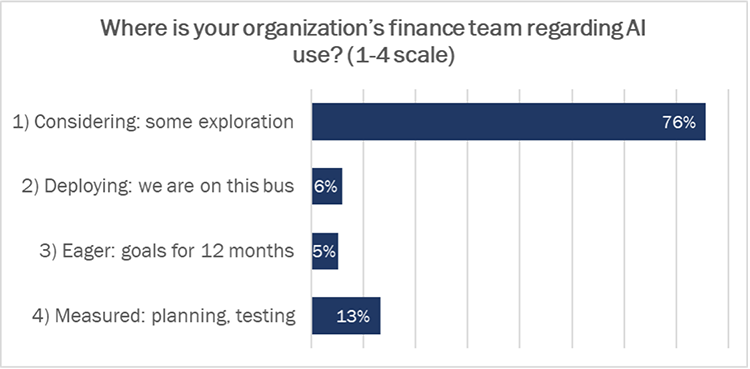Articles
Four Rules for Your AI Journey
- By AFP Staff
- Published: 11/1/2023
 In a recent AFP webinar, we asked attendees, “Where is your organization’s finance team regarding AI use?” The majority (76%) said they are in the beginning stages, “Considering it with some exploration.”
In a recent AFP webinar, we asked attendees, “Where is your organization’s finance team regarding AI use?” The majority (76%) said they are in the beginning stages, “Considering it with some exploration.”
“These results don't surprise me,” said Justin Croft, Vice President of Data Science & Solution Architecture for QueBIT Consulting. “Most of the time when I'm having conversations with customers or prospective customers, I find that people are excited about it, but they're not doing it yet. And it's generally because it’s difficult to do. If this were easy, then the survey results would look a bit a bit different.”
Finance should be driving AI deployment in organizations. There is an evolving marketplace of tools and options making it more accessible and affordable, and the technological coverage has never been better. “This topic represents the two halves of my career,” said Croft. “I began in corporate finance and was director of FP&A for years. I spent a lot of time doing analysis but then moved into data science, machine learning and artificial intelligence. I believe in the promise and potential for finance getting involved in AI.”
Amy Johnson, FPAC, former Senior Finance Manager at Amazon, views the benefits of AI from the perspective of what it can do for her team. It creates an opportunity to free up analysts’ hours to “innovate, think big and be curious,” said Johnson. “They're able to explore, to talk, to find new avenues of opportunity, rather than being an expert at a very small and repetitive task that can become boring to them. From a management standpoint, and for someone who uses AI every day, that's why it's important to me: I love to see what it does for my people."
The following are four key pieces of advice from Croft to help you get started on your AI journey.
1. Don’t start with AI.
It sounds counter-intuitive, but instead, center the business and customers first, and then ask how the technology can support strategy and operations. Croft’s key insight is that “the technology problem has largely been solved” because we have available tools at reasonable costs that require attainable skillsets. “It’s a matter of will and vision more than tech at this point, so let’s point our tools to solving business problems.”
2. Choose your use case to get a win that matters.
After aligning on a business-first approach, it is time to narrow further and choose the right initial project. It’s important to choose something manageable enough to succeed and get a win under your belt in order to generate momentum and learning behind your AI program. At the same time, it needs to be something that’s going to move the needle and people will care about. Croft advises to focus on use cases with quantifiable outcomes that align with important metrics and have enough impact to improve to the organization.
3. Build your team.
Here is the paradox about most AI projects: the people who build it are often not the people who use it. To be successful then requires that you bring into the project the end-users, so they understand what you’re trying to accomplish, how it works and why it matters to them. It is critical to get them on board early and engage them often.
Remember the metrics from rule 2? This impacts your team as well. You should be able to answer the following questions: How well is AI solving your use case? How will success be measured? How are we defining efficiency and effectiveness? Be transparent not only about how the AI works, and how it gets to the results. Once people have buy-in to the use case and technology, they'll start changing their behaviors, which will drive your metrics.
4. The ability to explain is more important than accuracy.
It's worth it to give up some accuracy to have a more explainable model. This idea of a black box is over. You need to be able to stand in front of your CFO and answer the question, “How did the AI come to this conclusion?” And you want your team to critically evaluate the AI output rather than blindly trusting the answers, and people just will not trust or engage with it over the long term. Rather, they should understand the business goal you’re trying to achieve and have some understanding of how these models work. You don’t need everyone to understand how it works at a high level, but you do need everyone to understand how accuracy is measured and reported.
Final Tips for Successful AI Implementation
There is an opportunity to do things bigger, better, faster and more. Finance can do things like bringing in external predictors, combatting human bias, crunching data quickly and uncovering unknown relationships.
The role of finance is to be anywhere that margin is at play, anywhere that you can influence the business, and anywhere you can apply your expertise.
To get you started in your AI implementation, these experts recommend the following in regard to people, processes and technology.
People
- Get a broad base of support; your data is cross-siloed, so your people need to be as well.
- Adjust your people strategy; consider adjusting job descriptions to dedicate resources to model ownership.
- This needs a sponsor, and it has to be part of the culture. If this is something new you're doing, the entire organization needs to be behind it.
- Figure out how to get the technical expertise you need, whether it is on-staff or via consultants.
Process
- Set up the rules of the road for how the process will run, keeping humans in the loop and having multiple eyes on it.
- The process never stops. Maybe you start with revenue, work it out, understand it, and then you move on to the next one.
Technology
- Get your data together so the system can access it.
- The ability to explain is more important than accuracy.
“It can be difficult to begin, but it can be done,” said Croft. “There's a lot of financial value in pursuing this, so it's worth the journey.”
Read the rest of the articles in this series:
Copyright © 2024 Association for Financial Professionals, Inc.
All rights reserved.

